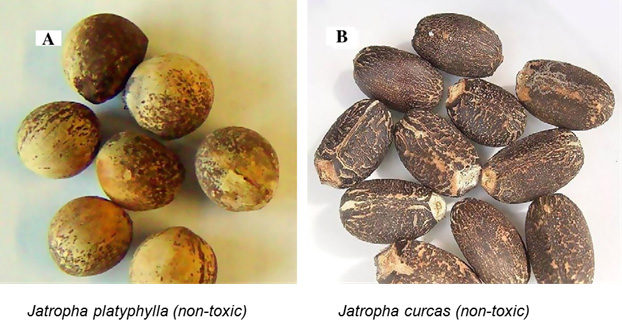Do you know of a non-toxic Jatropha and its merit as animal feed?
By Harinder P.S. Makkar, FAO, Rome
On hearing jatropha (Jatropha curcas) two things come to mind: it is an oil plant and its seeds are toxic. However, a non-toxic genotype of J. curcas exists in Mexico. Its seeds are consumed by people after roasting. Also after removal of the seed shells the kernel paste is used in local dishes in some parts of Mexico.
A comprehensive study at University of Hohenheim, Stuttgart, Germany (for original publications see: www.jatropha.uni-hohenheim.de) showed that the non-toxic jatropha seeds do not possess the main toxic agent, phorbol ester (a diterpene), which is present in the toxic jatropha seeds. However, the seeds of the non-toxic jatropha do contain lectins and trypsin inhibitors and their levels are almost similar to those in the toxic jatropha seeds. Lectins and trypsin inhibitors are heat labile and can be destroyed by heat treatment. The roasting of seeds of the non-toxic jatropha carried out before its consumption has been demonstrated to decrease the contents of these two antinutritional factors. There is another species of jatropha, J. platyphylla, which is also non-toxic and available in Mexico.
Table 1 gives chemical composition of seeds of J. curcas (toxic), J. curcas (non-toxic) and J. platyphylla. The crude protein and oil contents of kernels of these three jatrophas are almost similar. Sugar, starch and amino acid contents in kernel meals (residue left after removal of oil from kernels) are also almost similar. The levels of essential amino acids, EAAs (except lysine) are higher than those in the FAO reference protein for a growing child of 2–5 years of age. The amino acid composition of jatropha kernel meal and soymeal is similar (except lysine and the sulphur-containing amino acids cystine and methionine; lysine is lower and sulphur-containing amino acids are higher in the jatropha kernel meal than soymeal. EAA contents in jatropha kernel meals are higher than or similar to those in castor bean meal. Furthermore, the pepsin plus trypsin digestibility of jatropha kernel meal protein is similar (over 90%) to that of the heated soymeal.
Table 1. Chemical constituents of Jatropha curcas (toxic and non-toxic genotypes) and J. platyphylla kernels (Kernel: white inner portion after removal of shells from seeds) and kernel meals
| Jatropha curcas | Jatropha platyphylla | ||
| Proximate composition % in DM | Toxic | Non-toxic | |
| Crude protein | 26.6 ± 1.12 | 26.8 ± 1.24 | 27.1 ± 0.20 |
| Oil | 57.4 ± 0.50 | 57.5 ± 0.69 | 60.3 ± 3.54 |
| Ash | 4.0 ± 0.67 | 4.5 ± 0.56 | 3.9 ± 0.09 |
| Nutrients in kernel meal (% DM) | |||
| Crude protein | 63.7 ± 1.1 | 62.4 ± 2.6 | 66.4 ± 0.20 |
| Crude lipid | 1.14 ± 0.05 | 1.21 ± 0.04 | 1.14 ± 0.03 |
| Crude ash | 9.4 ± 1.01 | 9.1 ± 1.04 | 9.0 ± 0.58 |
| Neutral detergent fibre | 18.2 | 18.0 | — |
| Total sugars | 7.7–10.3 | 10.2 | 9.1 |
| Starch | 9.4–11.2 | 10.6 | 10.0 |
Values are mean + SD

Note: Both toxic and non-toxic J. curcas seeds look similar
The constraints in the utilization of non-toxic jatrophas as animal feed are the presence of lectins, trypsin inhibitors and phytate. The first two can be inactivated by heat treatment. Phytate content in jatropha kernels meal of all the three jatrophas is around 9%, which is almost three times higher than that in soymeal. The addition of enzyme phytase as additive is required in the monogastric animal diets containing kernel meals of non-toxic jatropha. In vivo studies conducted on rats and fish species demonstrate that heated kernel meals from the non-toxic jatropha can be a good substitute for soymeal and fishmeal in animal diets. When phytase is added to diets, the heated Jatropha kernel meal from the non-toxic jatropha can replace 50% of fishmeal in the diets of fish (e.g. carp and tilapia) and shrimps and 50% soymeal in diets of growing pigs.
The animal feed industry is growing at a rapid pace. The requirement for animal feed will substantially increase as a result of increased demand of animal products, especially from the emerging economies. The main input in any livestock production system is feed. This growth dictates greater use of feed protein sources other than fishmeal or soymeal. Jatropha products could be one of the candidates to supply a large amount of the protein required for the expanding feed market.
Further reading
Use of detoxified Jatropha kernel meal and protein isolate in diets of farm animals. Biofuel co-products as livestock feed: Opportunities and challenges
Available at:

